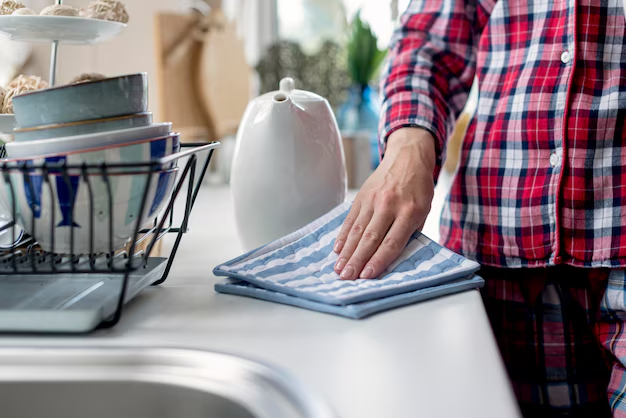Brightening Your Fridge: A Complete Guide to Disinfecting Your Refrigerator
Keeping your refrigerator clean is essential not only for the aesthetics of your kitchen but, more importantly, for the health of your household. A spotless fridge prevents food contamination, extends the lifespan of your appliance, and contributes to a peaceful, comfortable home. If you're overdue for a cleaning or aren't sure where to start, read on for a comprehensive guide on how to disinfect your refrigerator effectively and safely.
🛁 Why a Clean Fridge Matters
A refrigerator is a cornerstone of your kitchen, and its cleanliness directly impacts your health. A clean fridge minimizes the risk of harmful bacteria spreading, preserves the quality and taste of your food, and ensures the appliance runs efficiently. Neglecting to clean and disinfect your fridge could lead to unpleasant odors, mold growth, and worse—a breeding ground for bacteria that can affect stored items.
The Risks of a Dirty Fridge
- Bacterial Growth: Spills, crumbs, and expired items can harbor bacteria like E. coli and Salmonella.
- Cross-Contamination: Contaminants from raw foods can transfer to other items.
- Inefficiency: Debris can obstruct vents, causing the fridge to work harder and potentially increase energy bills.
Knowing the importance of a clean fridge is just the first step. Now, let's dive into the step-by-step process of disinfecting your refrigerator to maintain an ideal environment for food storage.
🧽 Preparation: Gathering Your Cleaning Supplies
Before you begin, you’ll need to gather some supplies and take preliminary actions to prepare for an effective cleaning session.
Essential Supplies
- Mild dish soap
- White vinegar or baking soda
- Microfiber cloths or sponges
- Old toothbrush or soft scrub brush
- Trash bags for tossing expired items
- Vacuum cleaner with a hose attachment (optional)
- Buckets and warm water
Initial Steps
- Unplug the Refrigerator: For safety, always unplug your fridge before starting any cleaning task.
- Empty the Contents: Remove all food items. Discard anything expired and set aside items that need refrigeration in a cool area.
- Take Out Shelves and Drawers: Most interior parts of a fridge are removable and should be cleaned separately.
This initial organization sets the stage for a thorough disinfecting process.
🌿 Cleaning the Inside of Your Refrigerator
With everything removed, you're ready to tackle the interior cleaning, ensuring that every nook and cranny is sanitized.
Cleaning the Shelves and Drawers
- Wash: Use warm, soapy water to wash shelves and drawers. Rinse and dry them thoroughly.
- Disinfect: Wipe them with a 1:1 solution of white vinegar and water, known for its natural disinfecting properties.
- Rinse and Dry: Rinse off any vinegar residue with clean water and dry the components completely before reassembling.
Addressing the Interior Surfaces
- Wipe Down Surfaces: Use a damp cloth with mild dish soap to wipe the inside walls. Pay attention to corners where grime and spills accumulate.
- Scrub Stubborn Spots: Use a toothbrush dipped in a baking soda paste (baking soda mixed with water) to gently scrub away stuck-on stains.
- Disinfect: Spray the vinegar solution inside and let it sit for a few minutes before wiping it dry.
Organizing and Reassembling
Once every component is clean and dry, reassemble your fridge and neatly return the food items, using organized containers and rotating items so older ones are at the front.
🚪 Don’t Forget the Exterior!
The outside of your refrigerator deserves attention too. Here's how to keep it shining.
Cleaning the Exterior
- Door Handles: These are high-contact areas. Clean with soap and water, then sanitize with vinegar to kill germs.
- Exteriors: Use a microfiber cloth with warm soapy water for stainless steel surfaces, heeding the direction of the grain. Dry to prevent streaks.
- Coils Behind or Below the Fridge: Use a vacuum to remove dust from the coils at least twice a year, improving efficiency and lifespan.
Useful Tip:
Consider using baking soda boxes or fridge deodorizers to maintain freshness post-cleaning. Replace these every 3 months for best results.
🕒 Setting a Cleaning Schedule
Consistency is key to maintaining a pristine fridge. Setting the right schedule can help ensure your appliance always remains a safe place for food storage.
Suggested Cleaning Routine
- Weekly: Conduct a quick check to remove expired items and wipe away any visible spills.
- Monthly: Perform a quick wipe-down of surfaces.
- Quarterly: Deep clean the fridge interior, disinfect all areas, and clean coils.
- Annually: Empty entirely for a thorough clean, including a detailed check of seals and gaskets.
📝 Handy Summary: Disinfecting Your Refrigerator
For swift reference, here’s a distilled version of the key steps to disinfect your refrigerator effectively:
- 🥛 Empty the Fridge: Start with emptying items, throwing away expired products.
- 🧼 Gather Supplies: Assemble dish soap, vinegar, sponges, and microfiber cloths.
- 🚿 Clean Removables: Clean shelves and bins with soap, sanitize with vinegar.
- 🦠 Tackle Stains: Use baking soda paste for stuck-on stains.
- ♻️ Reorganize: Reinsert clean shelves and neatly restock items.
- 🌟 Shine the Exterior: Wipe and sanitize doors and handles.
- 🔍 Regular Checks: Keep a schedule for routine maintenance.
Maintaining a clean fridge not only enhances its aesthetics but also supports the health and well-being of those who depend on it. By implementing these strategies consistently, you'll ensure your appliance runs efficiently and safely stores the food your family loves. Give your fridge the care it deserves, and it will undoubtedly reward you with fresh, delicious, and safe ingredients.
